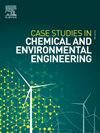Improving irrigation water quality using a pilot algal treatment system: A case study from northern Chile
Q1 Environmental Science
Case Studies in Chemical and Environmental Engineering
Pub Date : 2025-09-09
DOI:10.1016/j.cscee.2025.101281
引用次数: 0
Abstract
This study evaluates a three-stage integrated water treatment system for the removal of boron and arsenic from irrigation water in the arid commune of Camiña, northern Chile. The system combines ion exchange for boron removal, a 500 L reactor with non-living Chlorella vulgaris biomass for arsenic removal, and automated storage and drip irrigation. Operated continuously at 2.96 m3/day for one year, it achieved average removal efficiencies of 44 % for boron and 20 % for arsenic, with maximum removals of 78 % and 66 %, respectively.
Garlic crops irrigated with treated water showed improved agronomic outcomes. Large bulb frequency increased from 35 % to 49 %, and extra-large bulbs from 13 % to 23 %. A techno-economic analysis indicated operating costs of 2.61 USD/m3. A preliminary life cycle assessment estimated greenhouse gas emissions at 2.22 kg CO2-equivalent per m3 treated, with low chemical and biosorbent inputs.
This represents one of the first pilot-scale applications of an algal-based arsenic removal system directly integrated with crop irrigation. The system offers a modular, resource-efficient, and environmentally sustainable solution suitable for rural agricultural communities dependent on marginal water sources.

利用中试藻类处理系统改善灌溉水质:来自智利北部的案例研究
本研究评估了智利北部干旱公社Camiña灌溉水中去除硼和砷的三阶段综合水处理系统。该系统结合了离子交换去除硼,500l反应器与无生命的小球藻生物质去除砷,以及自动化储存和滴灌。以2.96 m3/天的速度连续运行一年,硼和砷的平均去除率分别为44%和20%,最大去除率分别为78%和66%。用处理过的水灌溉大蒜作物显示出改善的农艺效果。大灯泡的使用频率从35%增加到49%,超大灯泡的使用频率从13%增加到23%。技术经济分析表明,运营成本为2.61美元/立方米。初步生命周期评估估计,在化学和生物吸附剂投入较少的情况下,每立方米处理的温室气体排放量为2.22千克二氧化碳当量。这代表了藻类除砷系统与作物灌溉直接集成的第一个中试规模应用之一。该系统为依赖边缘水源的农村农业社区提供了模块化、资源高效和环境可持续的解决方案。
本文章由计算机程序翻译,如有差异,请以英文原文为准。
求助全文
约1分钟内获得全文
求助全文
来源期刊

Case Studies in Chemical and Environmental Engineering
Engineering-Engineering (miscellaneous)
CiteScore
9.20
自引率
0.00%
发文量
103
审稿时长
40 days
 求助内容:
求助内容: 应助结果提醒方式:
应助结果提醒方式:


